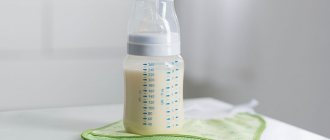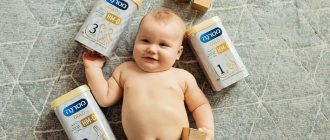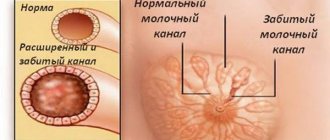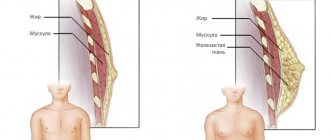Composition of infant formula
It is important to understand that baby food is subject to mandatory certification. This means that the state monitors the quality of the product and guarantees that it is safe for newborns. Why is not every formula suitable for every child? It's all about some ingredients and their quality. Let's figure it out.
All products consist of proteins, fats, carbohydrates, vitamins and microelements.
The amount of protein in baby food is an indicator that depends on the type of formula and age stage. There is no need to control it. But you can pay attention to the ratio of whey protein and casein. All manufacturers strive to bring the composition of baby food closer to the composition of mother's milk. Therefore, the ratio of proteins most often corresponds to their ratio in a woman’s mature milk - 60 to 40. The situation with fats and carbohydrates is a little more complicated.
There are three types of carbohydrates: sugars, starch and fiber (prebiotic). The main carbohydrate for babies under one year of age is milk sugar - lactose. In specialized mixtures, lactose can be replaced with other sugar. Babies begin to receive starch later - with the introduction of complementary foods with cereals. And a prebiotic is sometimes added to the mixture. These are dietary fibers that are not digested and provide a breeding ground for beneficial bacteria. Therefore, mixtures enriched with prebiotics help normalize digestion in the intestines.
Babies need different types of fats to develop - saturated and unsaturated, which are found in breast milk. Neither animal nor vegetable fats can independently reproduce this composition. Therefore, they are combined in infant formulas. Often, as a plant component, there is palm oil, which in its pure form is poorly absorbed by the child’s body. This is where the opinion about its dangers came from. However, it is important to know that there is a fraction of palm oil that is easily digestible. It's called palm olein. It is worth paying attention to the form in which palm oil is included in baby food.
Vitamins and microelements in baby food are how different brands differ from each other. Below are the recommended nutrient intake standards in the Russian Federation. You can evaluate the selected diet for compliance with the recommendations of the Ministry of Health.
| Substance | Physiological need per day | A comment |
| Energy | 110-115 kcal/kg body weight | for children under 1 year |
| Squirrels | 2.2-2.9 g/kg body weight | for children under 1 year |
| Fats | 5.5-6.5 g/kg body weight | for children under 1 year |
| Carbohydrates | 13 g/kg body weight | for children under 1 year |
| Cholesterol | no more than 300 mg | for children |
| Vitamin C | from 30 to 90 mg | for children |
| Vitamin B1 (thiamine) | from 0.3 to 1.5 mg | for children |
| Vitamin B2 (riboflavin) | from 0.4 to 1.8 mg | for children |
| Vitamin B6 (pyridoxine) | from 0.4 to 2.0 mg | for children |
| Niacin | from 5 to 20 mg | for children |
| Vitamin B12 | from 0.3 to 3.0 mcg | for children |
| Pantothenic acid | from 1.0 to 5.0 mg | for children |
| Biotin | from 10 to 50 mcg | for children |
| Vitamin A | from 400 to 1000 mcgret. eq. | for children |
| Vitamin E | from 3 to 15 mg current equivalent. | for children |
| Vitamin D | 10 mcg | for children |
| Vitamin K | from 30 to 120 mcg | for children |
| Calcium | from 400 to 1200 mg | for children |
| Phosphorus | from 300 to 1200 mg | for children |
| Magnesium | from 55 to 400 mg | for children |
| Potassium | from 400 to 2500 mg | for children |
| Sodium | from 200 to 1300 mg | for children |
| Chlorine | from 300 to 2300 mg | for children |
| Iron | from 4 to 18 mg | for children |
| Zinc | from 3 to 12 mg | for children |
| Iodine | from 60 to 150 mcg | for children |
| Copper | from 0.5 to 1.0 mg | for children |
| Selenium | from 10 to 50 mcg | for children |
| Fluorine | from 1.0 to 4.0 mg | for children |
Source: Methodological recommendations. 2.3.1.2432-08 “Norms of physiological needs for energy and nutrients for various groups of the population of the Russian Federation” dated December 11, 2008.
Where can I find mixtures without it?
Are there mixtures without it and what kind? to find baby food, including formula, that does not contain palm oil - study the composition. Conscientious manufacturers always indicate all incoming components in full and in Russian.
Buy food from specialized children's goods stores or large retail chains. There is less chance of buying a fake .
Read more about what products contain palm oil and how it can harm you here.
Nowadays, it has become almost impossible to find at least one product on supermarket shelves that does not contain a single so-called food additive. Read our materials about which “E-ki” are allowed and prohibited for use in food production, and whether E407, E322, sulfur dioxide E220, E171, E339, E331, E551, E500 are dangerous or not for the human body.
How to properly prepare formula for a baby
The ratio of the volume of dry powder and water depends on the type of mixture and the age of the child and is always indicated on the packaging. Let us recall the general rules that are important to follow:
- sterilize the bottle and nipple in a sterilizer or boil;
- wash your hands with soap;
- prepare boiled water at a temperature of 38-40 degrees;
- pour water into the bottle and add the required amount of powder;
- cover and shake until completely dissolved;
- Check your temperature by placing a drop on your wrist.
Now you can start feeding.
What and why is added to infant formula?
Whey protein. They replace the milk protein casein, because whey protein is better absorbed by the baby. It is also closer in amino acid composition to human milk.
Article on the topic
Instead of milk. What to feed your baby in the first year of his life
A mixture of natural vegetable oils - sunflower, corn, soybean, coconut, palm, etc. They replace partially or completely milk fat in order to provide the child with essential fatty acids, which are essential for the normal growth and development of infants, including the proper formation of the brain and retina of the eye. This allows you to increase the content of unsaturated fatty acids, the level of which is low in cow's milk. For example, human milk contains 8 times more linoleic acid than cow's milk.
Natural emulsifiers - lecithin, mono- and diglycerides. They are added to improve the absorption of fat in the intestines.
Carnitine is a vitamin-like compound that improves the oxidation of fats in the cells of organs and tissues of infants.
Lactose. Since its content in human milk is higher, this natural carbohydrate must be added to the milk formula. Lactose is often combined with another natural carbohydrate - dextrin maltose (or maltodextrin), which is a product of the partial breakdown of starch. It is digested and absorbed by babies even in the first days of life more easily than starch. But at the same time, it is slower than lactose, which ensures that children are satiated for a longer period of time and the possibility of extending the intervals between feedings. For the same purpose, malt extract, glucose syrup, corn and other types of syrup rich in dextrin maltose can be added to the mixture.
Taurine. It is a sulfur-containing amino acid. Taurine is needed mainly in the first months of life to build the retina and brain tissue. Cow's milk, unlike women's milk, contains little taurine. That's why it is added to adapted mixtures.
Babies on the “palm tree”. "AiF" visited the baby food production More details
Until what age is formula given to a child?
Mixtures are divided into stages or stages.
Stage 1 – from 0 to 6 months
Stage 2 – from 6 months to 12 months
Stage 3 – from 12 months
Stage 4 (less common) – from 18 months
Adapted nutrition is gradually removed from the diet as the transition to solid food occurs. Parents decide for themselves when to stop. It is important to listen to the child's needs.
Babies over a year old who have already switched to an adult diet are often given formula at night because it is convenient. Or before bed, because it’s high in calories and helps you sleep until the morning without waking up. Mothers sometimes cook porridge for their older children using the mixture - it’s tasty and healthy.
Comparison
Formulas should help babies develop, grow and stay healthy.
Therefore they must contain :
- iodine;
- nucleotides;
- polyunsaturated fatty acids;
- amino acids, in particular taurine.
Which milk formula does not contain structured palm oil, and which contains it?
Blends containing palm oil:
- Bellakt. In addition to vegetable oil, it also contains milk powder. Therefore, it is not suitable for all children and can cause allergies . But it contains all important for the baby.
- Hipp. is a very small amount of iodine and there is potato starch . A newborn baby does not need it.
- Agusha. Rich in taurine and nucleotides , but low in iodine and contains milk.
- Baby. The ingredients include soy - a child under one year old does not need it. But the content of nutrients is very high.
- Nan. There is soy and vitamin D, which prevents rickets .
- Nutrilon. High content of nutrients .
- Baby. There is soy , but the rest of the ingredients are very healthy .
Blends, without palm and coconut oils :
- Semilak. Contains soy and milk powder, but very high iodine .
- Nestozhen. There is little iodine, there is soy and milk powder. But there are also pribiotics that have a great effect on digestion.
- Nanny. There is little iodine and taurine, but there is vitamin D , lactose and prebiotics.
Another important point. If you manage to find whey , which must be demineralized , then buy it instead of other formulas - the composition is very similar to breast milk. And preference to those mixtures whose components include it.
NANNY 1 with prebiotics
This is a highly adapted food that is produced in New Zealand. It is intended for babies in the first six months of life, even before the introduction of complementary foods. “Nenny” promotes the harmonious development of the child’s body and strengthens its defenses.
The mixture is made from environmentally friendly milk of a special breed of goats, which is similar in composition to human milk. “Nenny” tastes good, has a characteristic “milky” smell and does not contain sugar.
Compound:
- Syrup.
- Goat milk (42%).
- Prebiotics: oligofructose, inulin.
- Lactose.
- Fish oil.
- Prebiotics: oligofructose, inulin.
- Sunflower, coconut, rapeseed oil.
- Taurine.
- Minerals: potassium, iodine, selenium, iron, calcium, copper, zinc, manganese.
- Vitamins: E, K1, A, C, D3, group B (B12, B1, B6, B5, B2, B4, H).
- Arachidonic acid.
- Lecithin.
Peculiarities:
- Does not cause regurgitation.
- Relieves constipation.
- Eliminates the appearance of bloating and colic.
- Prevents the occurrence of allergies.
- Suitable for children with allergies to formulas with cow's milk.
- It is prepared by diluting it in warm water, without requiring boiling.
The Nenny mixture is recognized as one of the best, both by experts in the field of baby nutrition and by consumers . She received many positive reviews. Parents whose children suffered from constipation and allergies were especially pleased with the mixture.
The production of Nenny requires large financial investments from the company, so this mixture has a high price. It ranges in Moscow stores from 1200 to 1400 rubles for a jar weighing 400 g .
Palm oil-free blends: list of brands
For those parents who are worried that palm oil will negatively affect the health of their baby, you can familiarize yourself with the list of brands that produce baby food without the use of this substance. At the same time, you can make sure that well-known expensive brands add it to their mixtures.
Infant formulas for newborns without palm oil are expensive and may contain questionable ingredients. These include beta palmitate and soybean oil. Based on the data presented, you can select infant formulas available on the modern market.
- Similac is produced in Denmark. There is no palm oil in this mixture. It was replaced by coconut, sunflower and soybean.
- Nutrilon and Cabrita are manufactured in the Netherlands. Contains beta palmitate.
- Nenny from New Zealand also contains coconut, sunflower and canal oil.
- Heinz from the UK - has beta palmitate.
Explore the list of blends with and without palm oil
There is a list of infant breast milk substitutes that contain palm oil.
- Swiss Nestozhen.
- Belarusian Bellakt.
- Germanic Hipp.
- Russian Agusha, Malysh and Malyutka.
- Dutch Nan.
All these brands have been known for a long time. If their products contained substances that had a negative impact on the health of children, they would be banned from production, and parents would not give them their preference.
Experts advise not to listen only to the opinions of other people. It is important to understand that artificial babies need mother's milk, but they cannot get it. Therefore, it is important to buy products that are as close to breast milk as possible. And vegetable fat from oil palm makes the mixture as similar as possible to mother’s milk in composition and consistency.
After all, breast milk and infant formula may equally not be absorbed by the baby’s body. Often, only on mother's milk does the baby experience constipation, allergies and gas formation. Therefore, if the mother does not have milk, it is necessary to select a formula taking into account the characteristics of the child’s body, even if a formula in which palm oil is present is more suitable for him. This will be more beneficial than cow's milk. Unprocessed milk protein can be harmful to a newborn's body.











